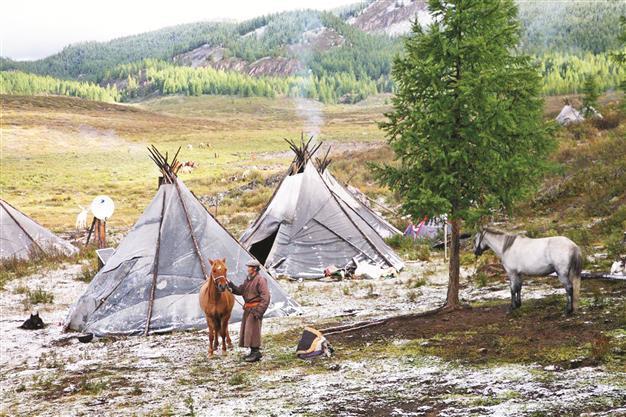Dukha, ‘lost Turks’ in Mongolia
ISTANBUL - Hürriyet Daily News

Dukhas have a very different way of living compared to other people in the world, They live the way people lived 10,000 years ago. DHA photos
A new documentary film illuminates the life of the Dukha, a small population of people living on the outskirts of the Sayan Mountains in Mongolia. To make the documentary, titled “Dukha Halkı Kayıp Türkler” (The People of Dukha, Lost Turks), Turkish Atlas magazine editor Özcan Yüksek and photographer Selcen Küçüküstel spent two months living in tents with the Dukha, who speak Turkish.
The documentary film was released late last week in Istanbul. According to Yüksek, the Dukhas have a very different way of living compared to other people in the world, “This is a society living in the prehistoric age and speaking the same language as us.”
“They live the way people lived thousands of years ago. They share everything. They have egalitarian relations and there is no crime. Men are not superior to women and women are not superior to men. They are traveling on wild migration roads with reindeers,” Yüksek said.
Yeditepe University Cultural Anthropology student Küçüküstel said she was able to communicate with the Dukhans within a short time and they were able to speak each other in a week. The Dukha’s Turkic language is in danger of becoming extinct, Küçüküstel.
Life in two groupsThe Dukha are a distinct tribe of Tyvan-lineage reindeer herders who have resided in northern Mongolia’s Hovsgol Province since the borders between Russia and Mongolia were officially closed in 1947 at the start of the Cold War.
Today, only a total of 200 to 400 Dukha people making up 44 families remain. They ride, breed, milk and live off of reindeer, despite the fact the reindeer population has dropped to approximately 600 since the 1970s, when it was an estimated 2,000. Much of the Dukha’s income today comes from tourists who pay to buy their crafts and to ride their domesticated reindeer.
The Dukha are divided into two major territorial groups, the Western Forest group and the Zun (Eastern Forest) group. The Western group tends to herd and migrate more traditionally in smaller groups of two to three families. They migrate almost every five weeks, or about 10 migrations per year, from their high-elevation summer camps to low-elevation winter camps, with spring and fall camps in between.
The Zun group practices a less-traditional nomadic form of life and resides in larger groups. The two groups present an interesting comparison of nomadic decision-making and adaptation in the face of outside influences such as tourism.
Hamid Sardar, a Harvard-trained anthropologist with the Geneva, Switzerland-based Axis-Mundi Foundation, concluded in a National Geographic article that, “The survival of the Dukha and their reindeer will directly depend on efforts to preserve their forest and the wild animals that live here.” Sardar recently spent three years on the trail of Mongolia’s last nomadic reindeer herders.
The Dukha believe that their ancestors’ ghosts live on in the forest as animals that give guidance to the living, according to a 2004 National Geographic report.
